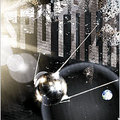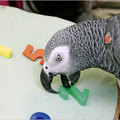IN his time, David Livingstone was Jacques Cousteau, Billy Graham and Bono, rolled into one — and the worldwide expansion of the telegraph allowed more people to learn, more quickly, more details about his exploits than the public had known about any previous explorer. Upon Livingstone's return from Africa to Britain in 1856, after having spent the previous 15 years exploring and evangelizing (and being more successful at the former than the latter, having made only one convert), he wrote a best-selling book, “Missionary Travels in South Africa,” made a legendary speaking tour, and then a much-publicized return to Africa. And yet, today, all of his words and deeds are overshadowed by that one line of Henry Morton Stanley's.
“Dr. Livingstone, I presume?,” the disingenuous greeting of a newspaper reporter eager to ingratiate himself with his subject, is all most people know about the old Scottish explorer. It seems particularly unjust that Livingstone's memory is banished to cliché — and, worse, one that suggests nothing of his character — because he so doggedly pursued true knowledge of the people he met in his wanderings. How did this man's memory get reduced to a sound bite? And why are we still repeating it?
Livingstone began hearing about Victoria Falls — called Mosi-oa-Tunya, or “the smoke that thunders,” by Africans — a full four years before he arrived there. It was a sacred site for the Batoka and other tribes, and Livingstone noted in his journal that one African chief, upon meeting white men for the first time, asked two questions: “Have you any smoke soundings in your country?” and “What causes the smoke to rise for ever so high out of water?”
He first saw the falls from an island (now named for him): he looked down at the water breaking into spray, whose “whiteness gave the idea of snow, a sight I had not seen for many a day.” Forcing his eye to follow the mist that tossed in drafts around the cataract, he found no end to the water's falling. At the roots of evergreens that grew above the lip, “a number of little rills run back into the gulf; but, as they flow down the steep wall there, the column of vapor, in its ascent, licks them up clean off the rock, and away they mount again. They are constantly running down, but never reaching the bottom.”
In the summer of 2005,, I began each day by disappearing for an hour into Livingstone's books, which are the funniest, most exciting and most inspiring chronicles I've read in years. “Starting, and looking half round, I saw the lion just in the act of springing upon me ... Growling horribly close to my ear, he shook me as a terrier dog does a rat.” The lion crunched Livingstone's left arm “to splinters,” and despite lack of anesthesia and antibiotics, he recovered “with only the inconvenience of a false joint in my limb.” He could never again raise his weak left arm to the level of his shoulder. During the next 30 years, he built three houses, laying and squaring every brick with his right hand.
Livingstone's singular integrity and drive make him seem, even more than most Victorians, part of a separate (admirable, and ludicrous) species. “On no occasion did I lay by,” he wrote, and he meant it. Today, few if any travelers embark upon journeys with a sense of purpose as powerful as Livingstone's. Many of our journeys, especially to underdeveloped areas, bear an odd resemblance to theater productions. Travelers choose from a slate of plays — Botswana safari, South African township tour — that deliver the satisfying glow of having been there, if we are self-aware, and also of having done that, if we are less so. In the world of Travelocity and two-week vacations, Livingstone's more open-hearted, empathic wandering is impractical, if not inconceivable. And yet if clichés of travel can't be escaped, they can still be enjoyed.
That November marked the 150th anniversary of Livingstone's discovery of Victoria Falls, and when I heard that an expedition would retrace a few days of the explorer's journey, ending on the island where he first saw the falls, I made up my mind to go. I wanted an experience that would give me a taste, however faint, of Livingstone's exploration. At waterfalls, I imagined, I had a chance of finding it.
DO you want to see the dead body?” Brighton asked. One by one, four friends and I had been ferried by canoe across the Zambezi, and then we hiked across white sand so fine it squeaked with every step toward the waterfall that David Livingstone believed to be the most beautiful in Africa before he saw Victoria Falls.
At Ngonye Falls, in Zambia's Western Province, two fishermen carrying spears climbed up to say hello: Brighton, whose fingers were shiny with the juice of mulutuluas, the tiny, wild sour plums that he shared with me, and Boniface, who wore a Hawaiian-style shirt covered with pictures of, not tropical fruit, but Saddam Hussein. (When I asked about his fashion statement, Boniface explained, “It's funny,” but he did not crack a smile.)
Brighton pointed toward a mottled pile of dry rocks that, in a moment, revealed what he promised: a human body jammed headfirst in riprap. Or maybe the top half was somewhere else. Regardless: two stick legs jutted and splayed, mummified, except for a rotting, fleshy left heel.
I asked what had happened, and Brighton said there had been a boat accident upriver six months ago, or a year ago, or three years ago, and the body had washed up here. That was all he knew. “We don't go near it,” he said.
“Because of spirits?”
“Because it stinks.”
I wanted to look closely, but when I looked, I looked away, and, by submerged but simple logic, found myself driven to heedless enjoyment of the day. In a natural Jacuzzi by the falls, the bubbles were so bracing that I impulsively took a gulp of Zambezi water and luckily paid no price for it later. We had the uncanny delights of this place all to ourselves that afternoon; white tourists come to Ngonye Falls only about once a week.
Falls are paradoxical places. Geologists describe them as among nature's most destructive forces, places where fluid water destroys solid rock, carving canyons so slowly that progress is usually imperceptible within the span of a human life. Their destructive power, however, is mostly masked by beauty, eliciting an all but universal response: a heightened awareness of, and exultation in, the mere fact of being present. Early in Norman Rush's “Mating,” the novel's narrator visits Victoria Falls, in whose roar, she says, “you stop thinking without trying. ... The first main sensation is about physicality. The falls said something to me like You are flesh, in no uncertain terms.”
We see falls as simultaneously exhilarating and restful, sites where the picturesque brings thrills and then peace in an emotional trajectory that traces the motion of water's fall. As features of the landscape, waterfalls are impossible to miss, and stubbornly indistinct. Try to show me a waterfall's edge.
Five days earlier, I had left the city of Livingstone — a gritty frontier town of about 100,000 that is known as the “tourism capital of Zambia” — to meet up with the anniversary expedition as it made its way toward Victoria Falls. The trip's headliner was the 61-year-old Sir Ranulph Fiennes, a distant cousin to the actors Ralph and Joseph. Deemed “world's greatest living explorer” by the Guinness Book of World Records, he made the first journey by land to both the North and South Poles, and discovered a lost city in Oman.
Some in the rest of our party — a local lodge owner, a wildlife artist, a flight safety engineer, a tour guide — seemed motivated not so much by the prospect of tracing the footsteps of David Livingstone but as to be in the presence of Sir Ranulph. When these men were schoolboys, he was the Commonwealth's equal of Neil Armstrong, and you could almost see their younger selves when, in camp, they peppered him with squirming, eager questions.
“Ran, do you pop your blisters, or not?”
Sir Ranulph, who seemed like a very nice person, scrunched his bird's-nest eyebrows, stretched his scarecrow legs, and said, “It's completely a personal taste.”
“Ran's taste pretty acidy!” piped up his wife, Lady Louise, between swigs of scalding tea, on a 90-degree day. When asked how he lost his fingers (he chopped the tips of several of them off in his garden shed, after suffering severe frostbite on an attempted solo trek to the North Pole), Sir Ranulph nodded at his wife and deadpanned, “She bites.”
We hiked along elephant paths in mopane forests screaming with locusts, through villages that have looked much the same since the 19th century. Most had no electricity, plumbing or — aside from secondhand, first-world clothing — industrially manufactured goods. Children asked our names and wanted us to play (one boy let me shoot his twig-and-gut bow-and-arrow). When adults asked where we were going, my fellow travelers shouted, “Victoria Falls!” while marching on — and I, still jet-lagged, fretted that we were missing chances to encounter the Africa that Livingstone had known.
On the third day, we reached the falls.
“Creeping with awe to the verge,” Livingstone had looked down into the gorge, and when I left the group to do the same, all the homework I had done drained out of me. Knees burning on black basalt, one hand grabbing a clump of dead grass, the other clutching my grimy Tilley hat, I pressed my head over Livingstone Island's edge.
I laughed because, I think, the falls seemed improbable, even absurd. There is a river — with rocks and boats and fishermen — plain, clear, slow-moving water — and then there is a crazed, frothing, broken, foaming force, gliding slowly through the misty air.
At this moment, it wasn't difficult to imagine why, 150 years ago, Victoria Falls was the only sight that drove Livingstone to the sheer juvenile exuberance of carving his initials into a tree.
As I looked at the rushing water, a half-dozen naked Zambians emerged from the river. They said they had been swimming at the edge.
One introduced himself: “My name is Rock Spider.”
“Your name is Rock Spider?”
“O.K., that is my nickname. My real name is Alphomega, but that is embarrassing.” (He spelled it for me later.)
On steppingstones, I followed Alphomega to the Devil's Pool at the falls' brink — a small green lagoon enclosed by rocks where, in the dry season, some people swim and even climb up on the very lip. He said, “It's safe,” and back-flipped into the air, hitting the water three feet from the edge.
When he surfaced, I asked, “Has anybody died here?”
He paused. “Are you going to jump?”
I did — and drifted with the current to the edge — then Alphomega held my ankles while I pushed out farther than I could have gone by myself, past my shoulders, to my sternum, while around me, the Zambezi tumbled 40 stories down. In less than the length of my body, the water changed. It looked normal, and then it didn't. Whole, and then in pieces. Soft, burbling stuff like water in the bathtub, and then: a jagged, cool explosion. Down through double rainbows, I saw the streaking, bubbled roar crash into rapids, the river starting its transformation back to normal, and I felt a reckless sense of peace. Later I realized this was the reassurance of a waterfall. Here, our everyday elixir, the substance of which we are literally made, seems to be shattered, and immediately, perpetually, restores itself.
All the glory and excitement of this place, and of any waterfall, has just one natural purpose: it's the river's way of getting back to normal. A waterfall occurs at the rift between a stream's force and its path. It is simultaneously a mistake and a correction, existing in order to erase itself.
The girl on the road held up a parasol as though she wanted to sell it. When we drove closer, the parasol became a mushroom.
For a dollar it was mine, and Boniface, our cook, used it as the base for a nutty, garlicky stew. In the following days, after I had parted from the Fiennes expedition, my guide, Claire Powell — picture Lara Croft in Coke-bottle glasses — drove her 4x4 down roads that were red mud gashes in the earth, taking me to the major waterfalls of the Kalungwishi River in the Northern and Luapua Provinces.
WE visited village headmen and priests, and even the Mwata Kazembe, the Lunda king, who sat on a wooden throne on an ancient, crumbling lion skin whose glass eyes had gone crossed. Wearing flip-flops, a Nike shirt and basketball shorts, his gaze occasionally strayed into the palace courtyard filled with goats, guinea fowl, dogs and a litter of piglets fighting for mango pits. He did his best to answer my questions about waterfall rituals, which he and his people had not performed in years. “None of the young people here are interested,” he said quizzically, “but you — come from Los Angeles. ...?”
Finally we reached the waterfall that, after Victoria, I most wanted to see: Kabweluma (in Bemba, kabwe means rock, and luma suggests the idea of one thing hitting another with force). The little information I had found about the place suggested it was thick with myth and spiritual meaning. “The Waterfalls of Zambia” by François d'Elbée and Mulenga Kapwepwe explains that Kabweluma is a “revered shrine sight,” and home to many frogs, incarnations of the resident snake spirit.
The locals I met did not live up to their reputation as snake worshipers (whether that's because they're actually not, or because they are uncomfortable talking about it to outsiders, is anybody's guess), but the place at least was satisfyingly hard to reach. On the home stretch to Kabweluma, we stopped to hoist a fallen tree from the road.
Under gray clouds and rumbling thunder, we parked and made our way among the pygmy palms, ducking webs of orb spiders, stepping over royal-blue stink bugs and finally emerging from the forest onto a platform of boulders slabbed with spongy moss, surrounded by a sight that no photograph could have prepared me for: 270 degrees of waterfalls in the shape of a natural theater, the splashing seats raked and rising as high as 75 feet, and all shapes and sizes of roaring cataracts and slender, tinselly spouts and clapping curtains.
The place was so magnificent that my first response was grandiose: I was onstage at La Scala, the Bastille Opera, the Met. When I looked down, scorching red dragonflies were dancing at my feet. Livingstone never saw Kabweluma Falls, but that is where I felt closest to him.
I stood there until I was soaked to the bone by the mist, amazed by that most powerful and self-consuming of travelers' clichés: the place more beautiful than anything you ever dreamed.
VISITOR INFORMATION
HOW TO GET THERE
Victoria Falls sits on the border of Zambia and Zimbabwe, so travelers must choose which country will be their point of arrival. The State Department warns American visitors to Zimbabwe to take safety precautions and urges them to register upon arrival with the United States Embassy in Harare. (Political and economic turmoil under President Robert G. ;Mugabe has caused fuel shortages and a surge of violent crime.) Zambia is the more popular point of arrival for Western visitors. Some travelers make day trips to Zimbabwe, which are easily arranged by most hotels, lodges and hostels.
Round-trip tickets from New York area airports to Livingstone, Zambia, begin at about $2,000.
WHERE TO STAY
Most hotels in Zambia set their rates in South African rands and United States dollars. High-end hotels accept credit cards and traveler's checks; most other businesses (including many safari and tour operators) do not. Take plenty of dollars, and make sure the bills are crisp, as most Zambians do not accept wrinkled or torn bills. You will use kwacha, the local currency, only for minor daily expenses, and possibly only in remote areas.
West of Livingstone, up the Zambezi from Victoria Falls, are several luxury lodges.
Islands at Siankaba (260-3-327490), www.siankaba.net, $410 a person per night in high season (June-October), $315 in low season (November-May), consists of seven secluded huts connected to the central lodge by a footbridge from which monkeys will flee as you walk to dinner. Price includes meals, drinks and house wines, airport transfers, river cruises and a tour of Victoria Falls.
The full colonial experience may be had at the Royal Livingstone Hotel (260-3-321122, www.sun-international.com, doubles $716), very close to the falls. For a taste of the backpacker scene, try Jollyboys International Backpackers hostel (260-3-324229; www.backpackzambia.com), where clean, comfortable private rooms go for $25 a night.
Ngonye Falls is about 45 miles from Mutemwa Lodge (27-11-234-1747; www.mutemwa.com), run by Gavin Johnson, a retired South African rugby star, and his wife, Penny. The lodge is known for its expert fishing guides, and an overnight visit to the falls is included in the rate of $320 a person per night.
Claire Powell of Thorn Tree Safaris (260-4-221-615; www.thorntreesafaris.com) in the northern regional hub of Kasama can arrange waterfall safaris to Kabweluma, among others. For a solo traveler, the charge was about $500 a day (cash only), but rates vary according to itinerary.
WHERE TO EAT
It is hard to stop worrying that everything is sufficiently boiled. Thus, much food for Westerners in Zambia is earnestly overcooked. The deftest meal I had in the country was at the Royal Livingstone, which serves oven-baked bream caught fresh from the Zambezi; with wine and appetizer, dinner was about $50 a person. The most memorable meal I had was at Mutemwa Lodge. After dessert, we caught flying ants from the air, held them by their wings with their bodies in the candle flames, sprinkled them with salt, and popped them in our mouths. The effect was as nutritiously blank, and as pleasingly crispy, as a Trader Joe's soy chip.
READING
“Zambia: The Bradt Travel Guide” ($24.95) is the most practical and comprehensive guide to the country. Martin Dugard's “Into Africa” is a fast-paced narrative of the adventures of Henry Stanley and David Livingstone. “The Life and African Explorations of David Livingstone” is a 19th-century pastiche of Livingstone's own writings and journalistic accounts of his career. “The White Nile” by Alan Moorehead, about the search for that river's source, sets Livingstone's career in the broader context of 19th-century African exploration. “Missionary Travels in South Africa” is the book that first won David Livingstone the hearts of the English public.




